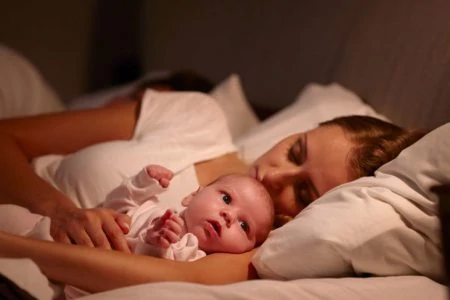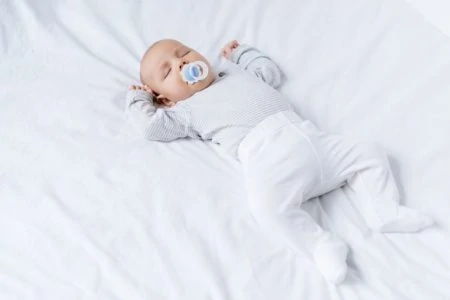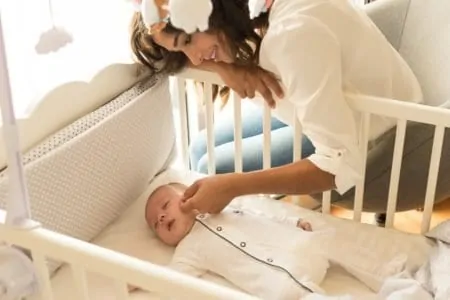Are you having separation anxiety at the thought of your baby being out of your sight? Are you worried about the dangers that could befall your bundle of joy during sleep?
Many moms feel unsettled or downright panicky at the thought of their baby sleeping in a different room from them. That’s only natural — your baby has slept with you for the past nine months. By now, it’s a habit.
But before you decide about co-sleeping vs. bed-sharing vs. room-sharing, you should take a closer look at the situation to ensure your baby will sleep in the safest environment possible.
Key Takeaways
- Room-sharing is recommended by the American Academy of Pediatrics for at least the first six months of a baby’s life.
- Bed-sharing is when the baby sleeps in the same bed with parents, while co-sleeping refers to having the baby in a bassinet or crib attached to the parent’s bed.
- Bed-sharing can be safe when practiced intentionally, but it’s important to follow safety guidelines to minimize risks such as SIDS and suffocation.
- Co-sleeping and room-sharing are considered safer options than bed-sharing and can help parents stay close to their baby while minimizing risks.
What Are My Options for Sleeping?
Sleep deprivation is a real challenge for new parents. Finding ways for everyone to get a good night’s sleep becomes a top priority. There are three ways to keep your baby near you when you sleep:
- Bed-sharing.
- Co-sleeping.
- Room-sharing.
Some parents use these terms interchangeably, but co-sleeping and bed-sharing are actually different things.
The American Academy of Pediatrics (AAP) recommends room-sharing for at least the first six months of your baby’s life and ideally for their first year (1). They do, however, caution against bed-sharing.
Let’s look at the difference between these methods and examine the pros and cons of each.
1. Bed-sharing
Bed-sharing is when your baby sleeps in your bed with you. It can be appealing to parents who can’t bear the thought of being away from their baby. It’s also convenient when you are breastfeeding.
You may be wary of sharing a bed with your baby because recent campaigns in the U.S. and the U.K. have spoken against it in an abundance of caution to avoid Sudden Infant Death Syndrome (SIDS) or a Sudden Unexplained Infant Death (SUID). These campaigns are not without controversy, though.
Research shows that bed-sharing can be safe, especially when your baby is breastfed and it is practiced intentionally (2).
There are many reasons parents opt to bed-share, including:
- Not wanting to leave their baby alone.
- Feeling worried about things like SIDS.
- For some babies, it’s the only way they sleep well.
- For financial considerations when parents can’t afford cribs.
- Breastfeeding is easier with your baby right beside you.
When I was pregnant with my second baby, my first baby was younger than 2 years old. Some nights, the only way she would sleep was next to me in my bed. Had she been younger than 1, I may have made a different choice. But since she was older, and I was pregnant and exhausted, it was a good solution for us.
Bed-Sharing Know-How
Here are a few things that can make bed-sharing dangerous for young babies. Some of these factors play a part in SUID/SIDS.
- A high bed, coupled with the lack of bed railings, makes falling a real possibility, which can be catastrophic for a young baby.
- Many adults prefer a softer mattress, certainly softer than baby cribs use. Soft mattresses can cause a baby to sink in and pose a larger suffocation hazard.
- Most adults generally like to sleep with blankets, and those blankets can easily get pulled up over your baby’s head. That can lead to suffocation quickly.
The risk of SIDS is greatest in your baby’s first four months of life. If you are worried about SIDS, you may want to wait until the peak risk has passed before bed-sharing. You can room-share or co-sleep until then (3).
Editor's Note:
Michelle Roth, BA, IBCLCIf you’re planning to bed-share, there are a few tips you should follow to keep your baby safe (4):
- Bottle-fed babies should co-sleep or room-share: Breastfeeding causes physiological changes in both the mother and child that make bed-sharing safer (5).
- Partner agreement is essential: Both parents sharing the bed should be on board with having their baby there, too.
- Don’t bed-share if you’ve been drinking or you’ve been taking drugs: It’s too risky for your baby. Anytime you’ve had alcohol or drugs — including over-the-counter or prescription medications that cause drowsiness — your baby should sleep elsewhere.
- Stay away if you’re a heavy sleeper: If you’re a heavy sleeper (or if your partner is), you shouldn’t bed-share. You’ll be less likely to notice any problems that are occurring.
- If you are obese, your baby should have a separate sleep space: Obesity is linked with a higher likelihood of sleep issues, which could interfere with your awareness of your baby beside you (6).
- Don’t beshare if you or your partner smoke: Even if you don’t smoke in bed, smoking during pregnancy and exposure to second-and third-hand smoke make bedsharing dangerous for the baby.
- Dress warmly: Wear a shirt that will keep you toasty, so you don’t have to pull the blankets up any higher than your waist. Dress your baby warmly to cut back on suffocation risks.
- Create a safe sleep space: Move your bed away from walls, and consider taking it off its frame. While that may make you nervous because of the risk of your baby falling from the bed, it’s easy for a baby to suffocate because they get trapped between the wall and the bed. Make sure your mattress is firm and never co-sleep on a waterbed.
- Never allow an infant to bed-share with siblings: And ensure there are no siblings or pets in bed with you and baby when you’re bed-sharing.
Need to know more about safe bed-sharing? Researcher Helen Ball and her team in the U.K. have a comprehensive website. James McKenna, an anthropologist and researcher at the University of Notre Dame, and his team are the leading experts in the U.S. on infant sleep.
Editor's Note:
Michelle Roth, BA, IBCLC2. Co-sleeping
If the thought of bed-sharing makes you nervous, you can opt for another form of sleep sharing. Co-sleeping can refer to when you sleep in your bed and your baby sleeps in a bassinet or crib that attaches to your bed or is right next to it. Think of it as a sidecar for your bed.
While the rest of the crib or bassinet has full sides, the side next to your bed is lowered or off altogether. That allows you to touch or see your baby in the night without having to get out of bed to do so.
Co-sleeping isn’t an ideal solution for everyone, but some moms truly benefit from it.
Here are some of the reasons you might want to consider co-sleeping.
- You want your baby right next to you but aren’t comfortable with the idea of bed-sharing.
- You’re breastfeeding your baby and want to be able to breastfeed in the middle of the night with as little disturbance as possible for everyone involved.
- You have a fussy sleeper on your hands, and being next to them seems to soothe your baby.
- You’re worried about the possibility of SIDS and recognize that room-sharing methods like co-sleeping reduce that risk.
- You have less anxiety when your baby is in sight.
- You love to wake up next to your baby in the morning — having that cute little face be the first thing you see is a great feeling.
If you decide to go with co-sleeping, you may be worried you’ll have to buy two cribs — one for co-sleeping and another for when your baby gets older and needs a permanent crib. But some cribs work both for co-sleeping and as independent sleeping areas.
Because co-sleeping products are still relatively new to the market, there aren’t a lot of products to choose from yet. Any co-sleepers will have to follow all the safety requirements that other beds must meet.
Safety Check
3. Room-sharing
If you’re looking for another safe way to share sleeping space with your baby, you’ll want to consider room-sharing. Room-sharing comes with a host of benefits for babies and parents.
- It can ease a parent’s anxiety.
- It can save money because you won’t have to buy a baby monitor.
- It greatly reduces the risk of a baby dying in their sleep.
- It makes breastfeeding more convenient for moms and babies.
- It may help a parent and baby sleep better.
- It doesn’t carry as much risk as bed-sharing and is a more time-tested method than co-sleeping is.
Room-sharing isn’t for everyone. While some parents find they sleep better with their babies in the room, others don’t fare as well. If you’re an extremely light sleeper, you might find that room-sharing, co-sleeping, or bed-sharing is too distracting to your sleep.
Babies make a surprising number of noises when they sleep, and every one of those sounds might be enough to disrupt your sleep and potentially theirs if you feel the need to check on them in their crib with every noise you hear.
FAQs
The Bottom Line
It’s natural for you not to want to take your eyes off your baby. Your number one duty is to protect them, and that’s easier to do when you’re in the same room.
Weighing your options and choosing the one that works best for your family is the key to everyone getting a good night’s sleep. Practice safety in any sleep situation to protect your baby, including when using a crib in their room. Make informed decisions about co-sleeping, if that’s your choice, so you can get the rest you need while keeping your baby safe.









